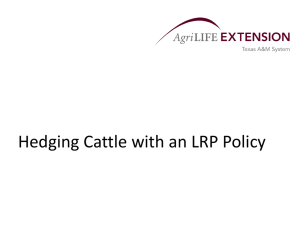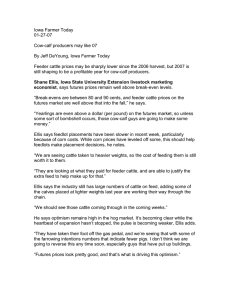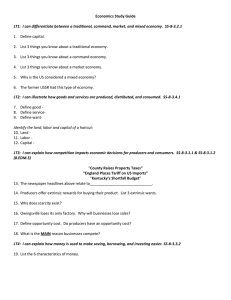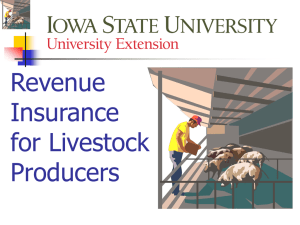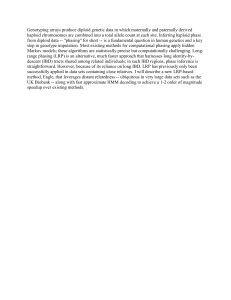Hedging Cattle with an LRP Policy Risk Management
advertisement
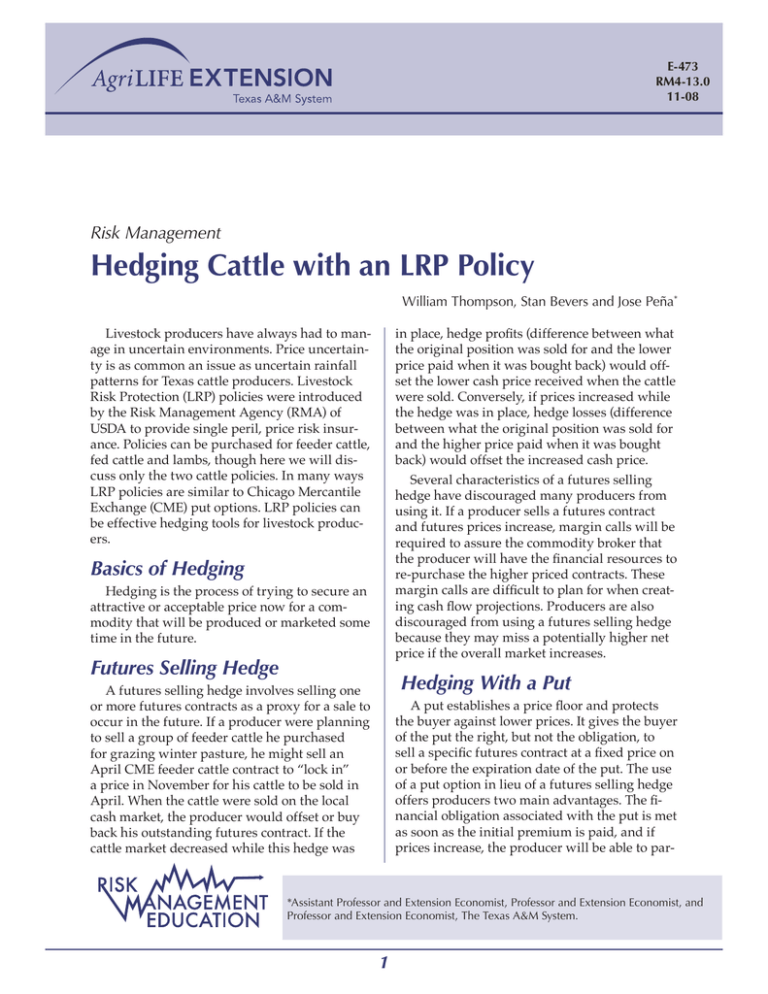
E-473 RM4-13.0 11-08 Risk Management Hedging Cattle with an LRP Policy William Thompson, Stan Bevers and Jose Peña* Livestock producers have always had to manage in uncertain environments. Price uncertainty is as common an issue as uncertain rainfall patterns for Texas cattle producers. Livestock Risk Protection (LRP) policies were introduced by the Risk Management Agency (RMA) of USDA to provide single peril, price risk insurance. Policies can be purchased for feeder cattle, fed cattle and lambs, though here we will discuss only the two cattle policies. In many ways LRP policies are similar to Chicago Mercantile Exchange (CME) put options. LRP policies can be effective hedging tools for livestock producers. in place, hedge profits (difference between what the original position was sold for and the lower price paid when it was bought back) would offset the lower cash price received when the cattle were sold. Conversely, if prices increased while the hedge was in place, hedge losses (difference between what the original position was sold for and the higher price paid when it was bought back) would offset the increased cash price. Several characteristics of a futures selling hedge have discouraged many producers from using it. If a producer sells a futures contract and futures prices increase, margin calls will be required to assure the commodity broker that the producer will have the financial resources to re-purchase the higher priced contracts. These margin calls are difficult to plan for when creating cash flow projections. Producers are also discouraged from using a futures selling hedge because they may miss a potentially higher net price if the overall market increases. Basics of Hedging Hedging is the process of trying to secure an attractive or acceptable price now for a commodity that will be produced or marketed some time in the future. Futures Selling Hedge Hedging With a Put A futures selling hedge involves selling one or more futures contracts as a proxy for a sale to occur in the future. If a producer were planning to sell a group of feeder cattle he purchased for grazing winter pasture, he might sell an April CME feeder cattle contract to “lock in” a price in November for his cattle to be sold in April. When the cattle were sold on the local cash market, the producer would offset or buy back his outstanding futures contract. If the cattle market decreased while this hedge was A put establishes a price floor and protects the buyer against lower prices. It gives the buyer of the put the right, but not the obligation, to sell a specific futures contract at a fixed price on or before the expiration date of the put. The use of a put option in lieu of a futures selling hedge offers producers two main advantages. The financial obligation associated with the put is met as soon as the initial premium is paid, and if prices increase, the producer will be able to par- *Assistant Professor and Extension Economist, Professor and Extension Economist, and Professor and Extension Economist, The Texas A&M System. 1 LRP policies ticipate in the market rally. If the futures market rises above the strike price, the option will be allowed to expire worthless and the producer’s net price will be the increased cash market price less the option premium paid. If futures prices drop below the selected strike price, the producer can use the increased value of the option to supplement the reduced cash price received for the calves sold. Producers have long felt that options have three distinct drawbacks. Put options can be relatively expensive, especially when a significant portion of the total premium is associated with the time value of the put. At times, light trading may mean that a seller for an option at the desired price cannot be found. In other cases the competitive open trading for options may mean that option prices have changed before a producer can get his option bought at the desired price. The fixed contract size of CME futures contracts makes them unwieldy for small to mid-sized producers. A single CME Feeder Cattle contract could be used to hedge the anticipated market price of approximately 67 head of feeder cattle weighing an average of 746 pounds. The “lumpy” size of CME futures or options can leave producers significantly over or under hedged. Table 1 presents contract specifications of CME Feeder Cattle and Live (Fed) Cattle contracts. LRP policies are single-peril insurance policies intended to protect against a price decrease in the overall market. After completing the policy application, producers select a coverage price, endorsement length, and the specific number of head and expected target weight of the cattle to be sold. The coverage price is a percentage of the expected ending value. These values and the associated rates are based on the current day’s closing futures prices, volume and volatility, and they correspond to different endorsement lengths. Endorsement lengths are in increments of about 30 days and can range from 13 to 52 weeks, though they are seldom available for more than 34 weeks into the future. If, at the ending date of coverage, the actual end value has dropped below the selected coverage price, the producer will need to file an indemnity claim within 60 days. RMA subsidizes all quoted premiums at a rate of 13 percent. It is crucial for producers to understand that the ending value of the LRP contract is not the cash price received or a closing futures price as of the end date of the policy. The LRP feeder cattle policy uses the Chicago Mercantile Exchange (CME) feeder cattle price index as the actual end value. This cash-settled commodity index is a mathematical calculation that averages the headcounts, weights and prices from numerous Table 1. Contract specifications for CME futures contracts. Trade unit Contract months traded Contract months listed Trading hours Daily limits Feeder cattle Live cattle 50,000 pounds 40,000 pounds Jan, Mar, Apr, May, Aug, Sep, Oct, Nov Feb, Apr, Jun, Aug, Oct, Dec 8 6 9:05 a.m. - 1:00 p.m. CST 9:05 a.m. - 1:00 p.m. CST $0.030/lb, $1,500 $0.030/lb, $1,200 2 livestock sales across the nation to determine its settlement price. The LRP fed cattle policy uses a weekly weighted average of the slaughter cattle prices in five areas, as reported by the Agricultural Marketing Service (AMS). This creates a slightly different basis calculation from traditional (local cash price minus futures price) basis calculations. Figure 1 illustrates the relationship between an un-hedged position (local price), a futures hedge, an LRP policy and a put option. The put option and LRP policy use the data presented in Table 2. The un-hedged position is simply the futures price less the estimated basis and is used to illustrate the risk of an unprotected price decrease, or the economic cost of each of the three risk management strategies. The futures hedge was initiated at $108 per cwt and includes estimated commission costs. The horizontal line of the futures hedge illustrates that once the hedge position is initiated, the net price received by the producer will remain constant subject to changes in the expected basis. Figure 1 also illustrates the similarities of using an LRP policy or a CME put option to protect against a price decrease during the production process. If the futures price rises above $108 per cwt, producers will realize a price that is above the floor they created with the LPR policy or put option. At prices above $108 per cwt, the difference between the local market price and the LRP or put option price is the cost of the respective premiums. LRP policies also have these advantages: • They provide coverage in months when CME contracts are not available. LRP and CME Put Option Comparisons LRP policies have many similarities to put options offered on CME futures contracts. As with a put option, producers are purchasing downside price protection while retaining upside potential. Table 2 illustrates the similar calculations used to determine the minimum net sales price for feeder cattle being hedged with LRP or put options. It is assumed that local market basis is $2 under the CME futures price. In this example, the LRP and the put option will provide a minimum sale price or floor of $101.77 per cwt and $102.66 per cwt, respectively. If futures prices increase above $108 (put option) or the CME Feeder Cattle Index rises above $107.90 in the case of the LRP policy, producers will be able to realize a higher price, less the cost of the respective risk management tool. • They instill confidence that the policy can/will be purchased at the rates quoted by RMA on their Web site. • All LRP premiums are tax deductible. Table 2. Calculation of minimum net selling price for feeder cattle to be marketed in May 2008—price as of January 18, 2008. LRP Put option Coverage/strike price ($/cwt) $107.90 (99.9%) $108.00 Less: Producer paid premium ($/cwt) $ 4.00251 $ Expected basis ($/cwt) $ -2.00 $ -2.00 Commission and interest ($/cwt) $ 0.12702 $ $101.77 $102.66 Minimum expected net sales price ($/cwt) 1 2 RMA subsidy of 13 percent has been deducted from premium. Interest only, RMA pays all sales commissions and other administrative costs. 3 3.10 0.2427 Figure 1. Net price received by producer. 120 115 110 105 100 95 90 85 Futures Hedge LRP ($107.9) Put Option ($108) 120 118 116 114 112 110 108 106 104 102 100 98 Local Price 96 $/cwt. Figure 1. Net price received by producer May Feeder Cattle Futures Futures Price May Feeder Cattle Price Other more complex strategies involve buying a put option to establish a floor under the price, and then selling either another put option (Bear Put Spread) or a call option (Window) to reduce the net cost of the purchased put. It would be possible to buy an LRP policy, and then use either of the above strategies, based on market outlook, to reduce the cost of the LRP policy. Since the expiration of the LRP and option contracts will not coincide, and the sale of an option carries substantial risks, you should be very cautious when mixing or combining these products. A valid marketing strategy often employed by options users is to “roll up” the minimum expected selling price when the market rises. This involves simultaneously selling or offsetting the existing put and purchasing another put with a higher strike price, a different expiration date, or both. This effectively lifts the minimum expected selling price while retaining the potential to benefit from further price increases. This is not possible with an LRP policy. Once in place, an LRP policy cannot be altered, offset or cancelled. Another potential disadvantage of trying to hedge your expected price with an LRP policy could be the limited number of coverage prices available for each end date of coverage. This becomes more of an issue as the end dates of coverage become more distant. Often only one or two coverage levels may be available for a specific end date, and in all cases the coverage level is less than the expected ending price. This may limit a producer’s ability to buy LRP coverage at the desired levels at the time cattle are purchased or placed on pasture/feed. CME options are available at strike prices both above and below the current futures price, giving producers considerable flexibility in tailoring a risk LRP Disadvantages as a Hedging Tool LRP policies cannot be purchased for coverage periods less than 13 weeks. This could be problematic if prices increased dramatically 60 to 90 days before the intended sales date and a producer wanted to put a price floor under his cattle at those higher levels. The fact that LRP policies are seldom offered for coverage periods of more than 34 weeks may also limit their usefulness relative to CME futures and options, which have contract months listed for nearly a full year (Table 1.). 4 management plan. LRP coverage prices, rates and expected ending values, and the number of different coverage levels available, can change daily. Producers electing to use LRP policies may need to be willing to wait until more coverage levels are offered, though they will be exposed to adverse price movements while they wait. Marketing Strategies LRP policies should be viewed as another tool available to livestock producers. The policies perform best when used for the right task, and can be disappointing when used for a function they were not designed for. Producers should identify their marketing or risk management objectives, risk tolerance and cost parameters, and combine that with their own market outlook and production schedule before implementing a marketing plan. Because LRP policies offer many of the same advantages as options contracts, producers need to become adept at evaluating and comparing the numerous LRP coverage levels and possible end dates to the array of options contracts available. LRP policies could be used for the following purposes: • Establish a minimum average sales price. • Scale-up LRP coverage on a limited number of head at a time if the market seems to be trending upward, as opposed to rolling hedges forward. • Combine LRP policies with a CME option contract to create a spread or window strategy. For more information on the use of futures and options for hedging, or for basic LRP information, refer to other Texas AgriLife Extension Service publications in this risk management series. Anderson, C., J. Smith, D. McCorkle and D. O’Brien. Hedging with a Put Option, L-5250. Bevers, Stan, Steve Amosson, Mark Waller and Kevin Dhuvetter. Using a Bear Put Spread, E-487. Johnson, Jason L. and Wade Polk. Rolling Up a Put Option as Prices Increase, E-142. Sartwelle, James D., Edward Smith, Terry Kastens and Daniel O’Brien. Selling Hedge with Futures, L-5252. Thompson, William, Blake Bennett and DeDe Jones. Livestock Risk Protection, E-335. • Insure against a catastrophic event by routinely purchasing LRP coverage at low coverage levels. Partial funding support has been provided by the Texas Corn Producers, Texas Farm Bureau, and Cotton Inc.–Texas State Support Committee. Produced by AgriLife Communications, The Texas A&M System Extension publications can be found on the Web at: http://AgriLifeBookstore.org. Visit Texas AgriLife Extension Service at http://AgriLifeExtension.tamu.edu. Educational programs of the Texas AgriLife Extension Service are open to all people without regard to race, color, sex, disability, religion, age, or national origin. Issued in furtherance of Cooperative Extension Work in Agriculture and Home Economics, Acts of Congress of May 8, 1914, as amended, and June 30, 1914, in cooperation with the United States Department of Agriculture. Edward G. Smith, Director, Texas AgriLife Extension Service, The Texas A&M System.

